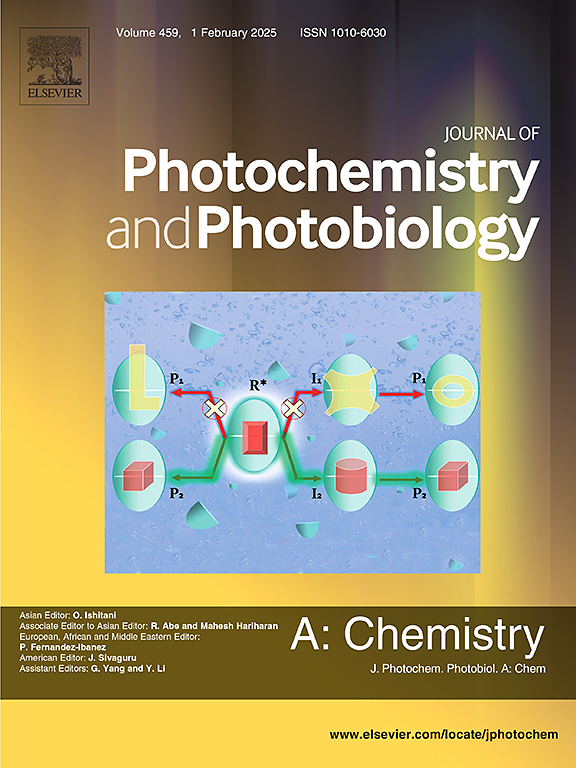A water-soluble phosphorus-dipyrromethene fluorescent probes for visualization of hydrogen sulfide in plants under abiotic stresses
IF 4.1
3区 化学
Q2 CHEMISTRY, PHYSICAL
Journal of Photochemistry and Photobiology A-chemistry
Pub Date : 2025-03-24
DOI:10.1016/j.jphotochem.2025.116409
引用次数: 0
Abstract
Hydrogen sulfide (H2S) usually acts as a gaseous signaling molecule that plays an essential role in regulating plant physiological activities. Consequently, in-situ detection of H2S in plants is of great significance for studying the physiological mechanisms of H2S within the plant system. In this study, a highly water-soluble probe with long-wavelength emission for in-situ detection of H2S in plants was synthesized. The ring-forming structure of phosphorus atom improves its water solubility. By introducing 2,4-dimethoxyphenyl to the boron-dipyrromethene (BODIPY) structure, DPOD-NO2 possesses a large Stokes Shift (76 nm). Furthermore, the long-wavelength emission at 616 nm reduces the interference from plant self-fluorescence. The nitro group was chosen as the recognition group, and the specific recognition of H2S was achieved through the intramolecular charge transfer (ICT) mechanism. The DPOD-NO2 shows excellent linearity within the H2S concentration range of 0.1 to 90 μM, with a detection limit of 0.063 μM. Importantly, DPOD-NO2 enabled successfully in situ detection and imaging of H2S in plants due to its excellent biocompatibility and detection performance. The imaging results reveal the variations in H2S content within the root systems of wheat seedlings under Al3+ stress, drought stress, and flooding stress. Consequently, this work presents a novel probe for further exploring the role and mechanism of H2S in plants’ responses to environmental stresses.

一种用于非生物胁迫下植物硫化氢可视化的水溶性磷-二吡咯烷荧光探针
硫化氢(H2S)通常是一种气体信号分子,在调节植物生理活动中起着重要作用。因此,原位检测植物体内的H2S对研究植物系统内H2S的生理机制具有重要意义。本研究合成了一种高水溶性的长波发射探针,用于植物中H2S的原位检测。磷原子的环状结构提高了其水溶性。通过在BODIPY结构中引入2,4-二甲氧基苯基,DPOD-NO2具有较大的Stokes位移(76 nm)。此外,616 nm的长波发射减少了植物自身荧光的干扰。选择硝基作为识别基团,通过分子内电荷转移(ICT)机制实现对H2S的特异性识别。DPOD-NO2在H2S浓度0.1 ~ 90 μM范围内呈良好的线性关系,检测限为0.063 μM。重要的是,由于其出色的生物相容性和检测性能,DPOD-NO2能够成功地在植物中原位检测和成像H2S。成像结果揭示了Al3+胁迫、干旱胁迫和洪水胁迫下小麦幼苗根系中H2S含量的变化。因此,本研究为进一步探索H2S在植物对环境胁迫反应中的作用和机制提供了一个新的途径。
本文章由计算机程序翻译,如有差异,请以英文原文为准。
求助全文
约1分钟内获得全文
求助全文
来源期刊
CiteScore
7.90
自引率
7.00%
发文量
580
审稿时长
48 days
期刊介绍:
JPPA publishes the results of fundamental studies on all aspects of chemical phenomena induced by interactions between light and molecules/matter of all kinds.
All systems capable of being described at the molecular or integrated multimolecular level are appropriate for the journal. This includes all molecular chemical species as well as biomolecular, supramolecular, polymer and other macromolecular systems, as well as solid state photochemistry. In addition, the journal publishes studies of semiconductor and other photoactive organic and inorganic materials, photocatalysis (organic, inorganic, supramolecular and superconductor).
The scope includes condensed and gas phase photochemistry, as well as synchrotron radiation chemistry. A broad range of processes and techniques in photochemistry are covered such as light induced energy, electron and proton transfer; nonlinear photochemical behavior; mechanistic investigation of photochemical reactions and identification of the products of photochemical reactions; quantum yield determinations and measurements of rate constants for primary and secondary photochemical processes; steady-state and time-resolved emission, ultrafast spectroscopic methods, single molecule spectroscopy, time resolved X-ray diffraction, luminescence microscopy, and scattering spectroscopy applied to photochemistry. Papers in emerging and applied areas such as luminescent sensors, electroluminescence, solar energy conversion, atmospheric photochemistry, environmental remediation, and related photocatalytic chemistry are also welcome.

 求助内容:
求助内容: 应助结果提醒方式:
应助结果提醒方式:


